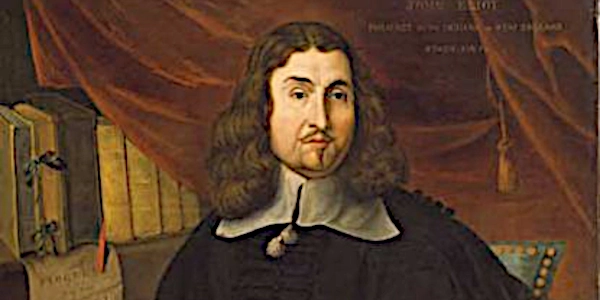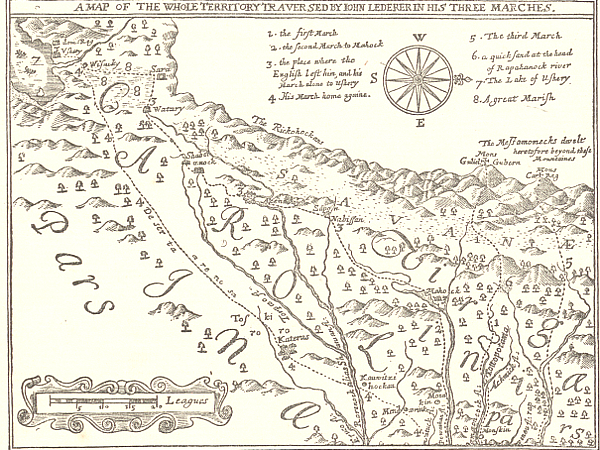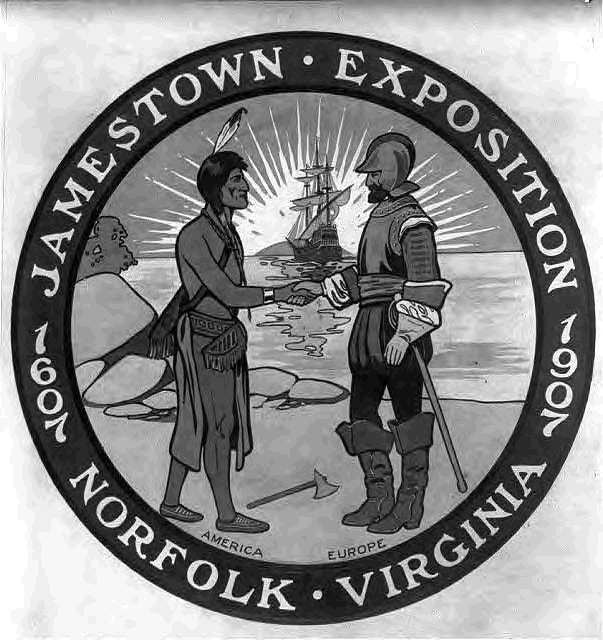Sponsor this page for $150 per year. Your banner or text ad can fill the space above.
Click here to Sponsor the page and how to reserve your ad.
-
Timeline
1663 Detail
1663 - Puritan missionary John Eliot publishes the Eliot Indian Bible, the first complete bible published in British North America.

John Eliot was a clergyman with the Massachusetts Bay Company who had been involved in the first book publication in British America, the Bay Psalm Book, a hymn book for the Puritans based on the Psalms, in 1644. He was one of thirty missionaries charged with its translation into English. So it should come as no surprise that John Eliot, as the colony grew, would seek to publish a bible, an American bible, that represented the Puritan beliefs. What was novel about the first bible published in British America, is that is was a bible to be translated into the Natick, a dialect of the Massachuset language spoken by the Algonquin tribes in the region, so that they could be converted. So nineteen years after the Bay Psalm Book, the missionary published its counterpart, the Eliot Indian Bible.
How did it start and why was it called the Eliot Indian Bible? The project had been going on for three years, with Stephen Daye, actual printer of the Bay Psalm Book, supervising Samuel Green, who would take over the Cambridge Press, on the first printing press in colonial America. They were assisted by Marmaduke Johnson, a newly arrived printer from England, who had brought with him eighty reams of paper and new type, including extra o's and k's that the Natick dialect would require. One thousand and fifty copies were printed. It was one thousand one hundred and eighty pages long.
Now that talks about the actual printing, but it was the translation that was an even more remarkable achievement. John Eliot had spent fourteen years translating the Geneva English Bible into the Algonquin language with the assistance of two people. One, John Nesutan, was a Harvard educated preacher, and two, was a young Nipmuck apprentice to Green, James Printer. Once the printer's were involved, it would become the largest printing project of the 17th century in the English colonies.
And what about its name. Well, that seems somewhat self-explanatory. It was translated and conceived by John Eliot, and it was for the Indian tribes of the area. However, it's actual name to the Algonquin, "Mamusse Wunneetupanatamwe Up-Biblum God."
The Impact of the Eliot Indian Bible
" ... the principall ende of this plantation ... to wynn and incide the natives of the country, to the knowlege and obedience of the onlie true God and Saviour of Mankinde ...," Massachusetts Bay Colony Charter.
It had been the mission of the Puritan colony from the start to convert the Algonquin tribes of the area to Protestant Christianity. John Eliot would be the principal missionary to that end, since his date of emigration on the ship Lyon on November 3, 1631 to the end of his life. He was called the "Apostle to the Indians," from the pulpit of his ministership of the First Church of Roxbury.
In 1646, Reverend John Eliot began preaching to the tribes in their own language in the local area, then expanding that at the "Praying Indian," permanent settlement at Natick. He believed that there should be villages served by Native American ministers who believed in Puritan values. That required publications that they could read; at first the Old Testament only in 1661 (one thousand five hundred copies), and then the entire Eliot Indian Bible in 1663. That was funded by the Society for the Propagation of the Gospel in New-England and Adjacent Parts, a missionary society.
However, the mission to convert the local tribes, outside the Praying Indian settlement, did not work. King Philip's War, which began in 1675, indicated that most of the Native American tribes of the area had no desire to become like the English. By the end of the war, the majority had been killed, enslaved, or driven out of the territory. Even the Praying Indian settlement converted were treated poorly. James Printer took the side of King Philip (an Indian warrior) against the colonists, though he restarted in the printing trade after his capture. John Nesutan, who had helped Eliot with the translation of the bible, was killed.
Most of the copies of the Eliot Indian Bible were destroyed in the war. John Eliot, himself, survived, and at seventy-two years of age, began again. He published a second, corrected, version of the bible in 1685. That version was used by the Native American community, Mashpee, on Cape Cod until the nineteenth century.
Do any copies of the Eliot Indian Bible, in either version, still exist? Yes. The Massachusetts Historical Society has a copy, although their version does not include the English title pages or the dedications to King Charles II. A copy of the 1st edition exits at the University of Illinois Library. Dartmouth College also has several copies, at least one of the first edition and second 1685 edition in the Bodleian Library. There are some sources that state Dartmouth has some incomplete other copies. There are other copies in a variety of libraries and museums. It is estimated that thirty-nine copies of the original printing exist today. Ten are supposedly in libraries in Europe.
Reverend John Eliot also founded the Roxbury Latin School in 1645. It is billed as the oldest independent school still in existence in North America.
Image above: Portrait of John Eliot, 17th century, unknown author. Courtesy Roxbury Latin School via Wikipedia Commons. Image below: Two pages photo from The Holy Bible: Containing the Old Testament and the New. Translated into the Indian Language. Cambridge, Massachusetts, 1663, translated by John Eliot, printed by Samuel Green and Marmaduke Johnson. Courtesy Library of Congress. Info source: Library of Congress; "The Holy Bible: Containing the Old Testament and the New. Translated into the Indian Language," 1663, translated by John Eliot, printed by Samuel Green and Marmaduke Johnson; "Witness to America's Past," masshistory.org; "Builders of the Bay Colony," 1930, Samuel Eliot Morison; "What was the First Bible Printed in the United States," 2016, atkinsbookshelf.wordpress.com; Wikipedia.

History Photo Bomb

How did it start and why was it called the Eliot Indian Bible? The project had been going on for three years, with Stephen Daye, actual printer of the Bay Psalm Book, supervising Samuel Green, who would take over the Cambridge Press, on the first printing press in colonial America. They were assisted by Marmaduke Johnson, a newly arrived printer from England, who had brought with him eighty reams of paper and new type, including extra o's and k's that the Natick dialect would require. One thousand and fifty copies were printed. It was one thousand one hundred and eighty pages long.
Now that talks about the actual printing, but it was the translation that was an even more remarkable achievement. John Eliot had spent fourteen years translating the Geneva English Bible into the Algonquin language with the assistance of two people. One, John Nesutan, was a Harvard educated preacher, and two, was a young Nipmuck apprentice to Green, James Printer. Once the printer's were involved, it would become the largest printing project of the 17th century in the English colonies.
And what about its name. Well, that seems somewhat self-explanatory. It was translated and conceived by John Eliot, and it was for the Indian tribes of the area. However, it's actual name to the Algonquin, "Mamusse Wunneetupanatamwe Up-Biblum God."
It had been the mission of the Puritan colony from the start to convert the Algonquin tribes of the area to Protestant Christianity. John Eliot would be the principal missionary to that end, since his date of emigration on the ship Lyon on November 3, 1631 to the end of his life. He was called the "Apostle to the Indians," from the pulpit of his ministership of the First Church of Roxbury.
In 1646, Reverend John Eliot began preaching to the tribes in their own language in the local area, then expanding that at the "Praying Indian," permanent settlement at Natick. He believed that there should be villages served by Native American ministers who believed in Puritan values. That required publications that they could read; at first the Old Testament only in 1661 (one thousand five hundred copies), and then the entire Eliot Indian Bible in 1663. That was funded by the Society for the Propagation of the Gospel in New-England and Adjacent Parts, a missionary society.
However, the mission to convert the local tribes, outside the Praying Indian settlement, did not work. King Philip's War, which began in 1675, indicated that most of the Native American tribes of the area had no desire to become like the English. By the end of the war, the majority had been killed, enslaved, or driven out of the territory. Even the Praying Indian settlement converted were treated poorly. James Printer took the side of King Philip (an Indian warrior) against the colonists, though he restarted in the printing trade after his capture. John Nesutan, who had helped Eliot with the translation of the bible, was killed.
Most of the copies of the Eliot Indian Bible were destroyed in the war. John Eliot, himself, survived, and at seventy-two years of age, began again. He published a second, corrected, version of the bible in 1685. That version was used by the Native American community, Mashpee, on Cape Cod until the nineteenth century.
Do any copies of the Eliot Indian Bible, in either version, still exist? Yes. The Massachusetts Historical Society has a copy, although their version does not include the English title pages or the dedications to King Charles II. A copy of the 1st edition exits at the University of Illinois Library. Dartmouth College also has several copies, at least one of the first edition and second 1685 edition in the Bodleian Library. There are some sources that state Dartmouth has some incomplete other copies. There are other copies in a variety of libraries and museums. It is estimated that thirty-nine copies of the original printing exist today. Ten are supposedly in libraries in Europe.
Reverend John Eliot also founded the Roxbury Latin School in 1645. It is billed as the oldest independent school still in existence in North America.
Image above: Portrait of John Eliot, 17th century, unknown author. Courtesy Roxbury Latin School via Wikipedia Commons. Image below: Two pages photo from The Holy Bible: Containing the Old Testament and the New. Translated into the Indian Language. Cambridge, Massachusetts, 1663, translated by John Eliot, printed by Samuel Green and Marmaduke Johnson. Courtesy Library of Congress. Info source: Library of Congress; "The Holy Bible: Containing the Old Testament and the New. Translated into the Indian Language," 1663, translated by John Eliot, printed by Samuel Green and Marmaduke Johnson; "Witness to America's Past," masshistory.org; "Builders of the Bay Colony," 1930, Samuel Eliot Morison; "What was the First Bible Printed in the United States," 2016, atkinsbookshelf.wordpress.com; Wikipedia.








